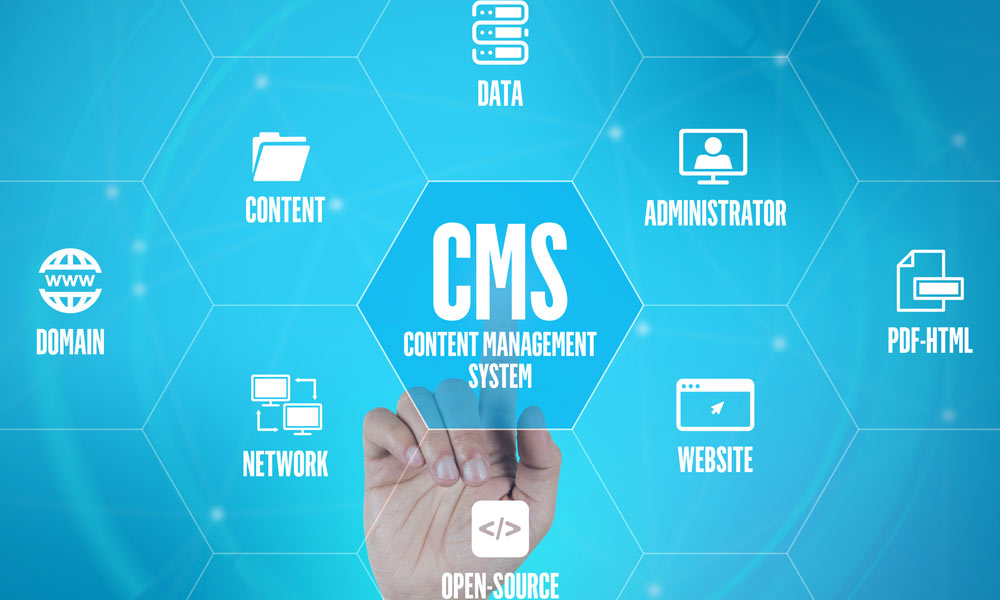Advertising disclosure
Hosting Canada is community-supported. We may earn a commission when you make a purchase through one of our links. Read Disclosure.
The 5 Most Popular CMS by Market Share (Top Picks for 2025)
Finding the best Content Management System (CMS) among the most popular CMS in Canada is a critical step for small businesses in the hubbub of the Canadian digital market. Generally, the ideal one should provide security, satisfying website performance, a wide range of search engine optimization features, and a great user experience.
Since Canada has rolled out many data privacy regulations to protect data, businesses in Canada now have to focus on choosing a content management system that is in compliance with privacy laws, on top of the general performance and support considerations.
Key Criteria for Evaluation of the Best CMS for Your Business

There are various key factors to consider if you want to find the best CMS platforms in Canada. We picked our top CMS recommendations based on things like performance, support, features and value for money:
- Performance and Uptime: Consistent and reliable performance should be a high priority. Moreover, a nearly 100% uptime will ensure your website will stay up and running, even during traffic surges. Choosing a hosting service that offers local data centers for Canadian businesses will significantly increase the chance of having a reliable and uninterrupted experience.
- Customer Support: Customer support may not seem that important at first, but when you encounter a technical issue or a confusing situation, it will become the most crucial aspect of the experience. The ideal system should offer 24/7 customer support with effective technical knowledge. Moreover, the support team should be familiar with local business challenges, such as Canadian regulations.
- Essential Features: Top CMS providers offer these three essential features at the same time: security, ease of use, and scalability. We picked our top recommendations based on the platforms that provide robust security measures, combined with a user-friendly interface and scalable architecture that can support your business as it grows.
- Pricing and Value for Money: We recommend CMS services that are reasonably priced. It's also important to look out for any hidden costs, and to ensure that you get all the necessary features with one payment.
Stand-out Recommendations for Small Businesses Looking to Grow
Every small business aiming for a strong online presence, inevitably goes through a phase of researching the best CMS for its unique needs. Choosing the ideal CMS is not only about your current priorities, but also about the business's potential, and how the platform can support it in the future.
Note: The following market share data for each CMS is based on monthly W3Techs reports.
1. WordPress: The King of CMS Platforms
WordPress is the market leader globally and in Canada. With a 61.7% market share, it’s by far the most popular CMS in the world. The platform is incredibly flexible, with a wide range of plugins and a huge community of users.
The open-source nature of it allows business owners and developers to create highly customized websites. Since the CMS does not dictate where the user’s data is stored, Canadian businesses are free to choose Canadian data centers to host their websites. This helps to ensure that they are aligned with Canadian privacy laws.
Why Should I Use WordPress?
WordPress powers a significant portion of the web as we know it today, and since it’s open-source, there are many free tools and plugins that can help users personalize their websites. Moreover, due to its popularity, tons of guides and instructions by professional users are available for free.
Required Skill Level
WordPress is a user-friendly platform for newcomers. Business owners can even take advantage of website builders such as Elementor to simplify the process. On the other hand, many tools and parameters are available for professional users and developers to customize and build unique websites. So, WordPress is optimized for all skill levels, hence its popularity among all audiences.
Successful Websites Built with WordPress
One Canadian example of an impressive website created with WordPress is Alba Condos. It’s a residential development located near Toronto, Canada that focuses on homes with modern aesthetics. The website is designed to provide an immersive journey through the development’s highlights. It offers high-quality pictures and interactive floor plans.
Other well-known websites created with WordPress include:
- Sony Music
- TechCrunch
- Microsoft News
- Facebook Newsroom
- The New York Times
- Variety
2. Shopify: The Go-To Platform for E-Commerce
If you’re looking to start your own e-commerce business, then Shopify is the most popular e-commerce focused platform with 6.7% of the pie. This CMS provides seamless integration with various payment options, including Canadian gateways. It makes the process of growing an online business much simpler, by handling most of the technical tasks.
Shopify also provides inventory management tools and tons of customizable themes.
Why Should I Use Shopify?
Since Shopify is a Canadian company, it’s fully compatible with Canadian privacy laws. Considering the focus on online stores, it’s perfect for small Canadian businesses trying to sell products or services. The 24/7 customer support and fast responses are other reasons to choose Shopify. If you would like to know more about it, check out our Shopify review.
Required Skill Level
Shopify is an ideal option for beginners and business owners who don’t want to deal with any coding. The CMS handles most of the technical aspects of creating online shops. However, the platform offers enough tools to satisfy the customization needs of developers.
Successful Websites Built with Shopify
The Last Hunt is a Canadian sports clothing shop founded in Montreal, in 2010. This company benefits from Shopify’s many features to sell its products through a responsive and bilingual website. The Last Hunt has praised Shopify’s user-friendly interface, which allows customers to follow the status of an order quickly and offers fast customer support.
Other well-known websites created with Shopify include:
- ColourPop Cosmetics
- Gymshark
- Fashion Nova
- Red Dress Boutique
- Jeffree Star Cosmetics
3. Wix: The Ultimate Drag-and-Drop Website Builder
Our comprehensive Wix review details this platform's incredible ease of use. The intuitive drag-and-drop building tools allow you to effortlessly add buttons, visuals, and other elements to the design. This CMS currently holds 4.9% of the market share and is known for its versatile and flexible nature.
In addition, this platform is equipped with AI-powered features. This means business owners and website developers can explain their goals in the chat and receive helpful results to tweak their interfaces. IT provides advanced design features, including animations, scroll effects, and interaction, without requiring any coding skills.
Why Should I Use Wix?
It has a user-friendly interface and beginner-friendly creation tools. In fact, that's why many small businesses choose it. If you want to achieve a visually pleasing website design within minutes, Wix is for you.
Required Skill Level
Wix is a great option for beginners as it requires no technical or coding knowledge. Every step of the website building process can be completed with easy-to-use customization options and AI assistance. However, there are still advanced features for professional developers to code and create without limitations.
Successful Websites Built with Wix
Ogi Eyewear is one of the notable websites created with Wix. They have gone for a simple design, which has turned out to be quite effective. Users can easily navigate the website, find their favorite products, read their descriptions, and place orders with a few clicks.
Other well-known websites created with Wix include:
- Animal Music
- Izzy Wheels
- Mananalu
- Sonja van Duelmen
- French Knot Studios
4. Squarespace: The CMS for Creative Professionals
Squarespace is a website builder full of interesting templates in different categories, such as photography, art, design, real estate, travel, and more. This CMS is focused on simplicity and aesthetics, so it attracts many artists and creative businesses. It currently has 3.2% of the market share.
It is an all-in-one package that combines website design, hosting, and security in one service. So, users can opt into one of the plans this CMS offers and, without additional work, have their sites up and running. In addition, it provides built-in SEO tools that can easily improve the website's performance on search engine results pages.
Why Should I Use Squarespace?
Squarespace is an excellent choice if you want one service for all your website needs, including hosting and templates. Due to its minimalistic approach to website design, It’s perfect for creative businesses and personal websites.
Required Skill Level
This CMS is highly beginner-friendly and offers an intuitive drag-and-drop editor without requiring any coding knowledge. There are plenty of templates in different categories that can help beginners find suitable designs for their needs.
Successful Websites Built with Squarespace
The Sorry Girls is one of the many successful Canadian websites made with Squarespace. Becky Wright and Kelsey MacDermaid, the founders of this business, are known for their spectacular work in interior design. They also produce podcasts and YouTube for their followers.
Other well-known websites created with Squarespace include:
- Flaneur Magazine
- Supernatural Kitchen
- Jones BBQ
- Blue Dog
- Gretel
5. Joomla: The Powerhouse for Customization and Scalability
Joomla still holds 2.2% of the market share, and many well-known websites take advantage of this CMS in Canada and other countries. It’s a powerful open-source platform that allows the building of highly customizable and scalable websites.
Due to its strong SEO capabilities and a large library of extensions, Joomla is popular among businesses and organizations that want to create complex e-commerce and enterprise websites. Joomla offers advanced security features and built-in capabilities, perfect for sensitive websites that need a high level of protection.
Why Should I Use Joomla?
If you need a CMS that provides full control of design and structure, Joomla is a suitable pick. With built-in security measures and high scalability, it’s perfect for large enterprises. Since it’s open-source, Canadian businesses can easily have control over data and make a website that is fully compliant with Canadian privacy laws.
Required Skill Level
Joomla is not a drag-and-drop website builder. It requires some knowledge of web development. So, beginners have to invest some time to learn and fully benefit from its scalability. Their team kindly created a detailed Joomla documentation for users. Alternatively, if you want to communicate with humans you can visit the Joomla! Forum.
Successful Websites Built with Joomla
7toucans is a Canadian travel social network website made with this website builder. The developers integrated some paid components, including Virtuemart, to enable users to participate in online travel auctions. They were able to customize the website highly and add lots of extra functionality and components to it, thanks to Joomla’s scalability and its flexible nature.
Other well-known websites created with Joomla include:
- Harvard University
- The United Nations
- Linux
- iTWire
- Champions Sports Academy
CMS Name | Key Features | Performance | Pricing | Customer Support |
WordPress | Open-source, extensive plugins, SEO tools, huge community | Depends on the hosting service | Free as self-hosted, paid plans start from $4 | Email and live chat support (paid plans), community support |
Shopify | Advanced features for online shops, e-commerce tools | High performance and uptime | Starts from $25 per month | Localized support for Canadians |
Wix | AI-powered, drag-and-drop builder | High performance and uptime | Starts from $17 per month | 24/7 customer support |
Squarespace | All-in-one package, SEO tools, and a wide range of templates | High performance and uptime | Starts from $16 per month | 24/7 customer support |
Joomla | Open-source, highly scalable, SEO tools, built-in advanced security features | Depends on the hosting service | Free core, paid extensions | Community support |
Essential Tips for Choosing the Right Provider for Your Needs

Finding the right CMS provider is highly dependent on personal factors, like business size and technical expertise. Here are some important tips that can guide you in the right direction:
- Consider your technical knowledge: If you have access to a dedicated development team (or you are familiar with coding) platforms such as WordPress and Joomla, offer deep customization options. Otherwise, you would be better off with simpler CMS providers, such as Wix and Squarespace.
- Decide based on your business size: For a big business with numerous services and products, highly customizable CMS platforms like Joomla can be a better choice. Smaller businesses will benefit from easy-to-use platforms, such as Shopify and Wix.
- Plan for future growth: Go for a scalable CMS if your plan is to grow your business with more products, or to eventually provide more capabilities with your website. If you want to stick with your current niche, scalability will matter less.
- Evaluate the long-term cost: Even if a CMS offers an affordable plan for the short term, you have to pay attention to the potential cost of your business in the long run. Factor in additional costs, such as paid plugins and extensions.
- Check for quality customer support: Companies planning to go for a paid service, should be able to access the customer support team easily. Before paying for the service, test it with a technical question to see if you can get an effective answer.
Take the Next Step: Find the Best CMS for Your Canadian Site
Picking the best CMS platforms in Canada can be complicated. In 2025, performance, security, user-friendly interface, and pricing remain the most important criteria.
On top of that, Canadian businesses should pay attention to the data privacy laws of Canada and use a CMS that allows compliance with them. WordPress and Joomla are the best options for highly customized websites. On the other hand, Wix, Shopify, and Squarespace are suitable for smaller businesses and individuals.
If you’re a beginner and stuck between our recommendations, we suggest you read the Wix vs Squarespace article.















